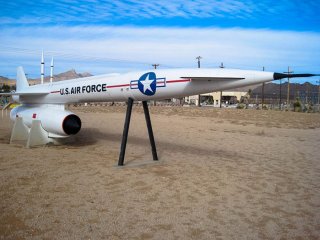Hound-Dog: This Elvis-Inspired Missile Could've Destroyed Russia
The AGM-28 'Hound Dog' was fast, destructive, and abundant.
Here's What You Need To Remember: In a procurement environment moderns can only marvel at, the Hound Dog went from official request to delivery in only thirty months.
As peer opponents field ever more sophisticated air defenses the U.S. Air Force requires ever more ingenuity to get its B-52 bomber force to its targets. The Air Force needs a large missile its bombers can carry with them to strike radars, missile sites and air bases hundreds of miles ahead of the slower manned aircraft.
Is it 2018 and the subject the Long Range Stand-Off Weapon (LRSO)? No, it’s 1956 and the subject the AGM-28 “Hound Dog” cruise missile. Choosing the same solution (for the same aircraft!) decades apart seems like eye-roll material, but modern drone makers can draw much inspiration from the older missile.
By the mid 1950s Soviet air defenses could shoot down American bombers well before they got within bombing range of important targets. In 1956 the Strategic Air Command (SAC) asked for a supersonic cruise missile big enough to carry an H-bomb several hundred miles, and small enough for a B-52 to carry along with its bomb load.
In late 1958 North American Aviation won the contract with a design based upon its rather troubled Navaho missile. The resulting weapon was as elegant as a rapier—a long sleek thin fuselage sporting small delta wings and canards perched atop a stout engine pod over a third its length. The pod contained a compact Pratt & Whitney J52 turbojet like those powering the Navy's A-4 Skyhawk, hot-rodded to push the missile to Mach 2.
The missile’s onboard inertial navigation system—a key development of the Navaho program—updated by a star tracker in its mounting pylon, let it place its 1.45-megaton W-28 warhead within two miles of its target at six-hundred-miles range.
It ran like a scalded dog and took its name from an Elvis Presley tune—the Hound Dog.
In a procurement environment moderns can only marvel at, the Hound Dog went from official request to delivery in only thirty months. A few days before Christmas 1959 SAC chief Gen. Thomas Power formally accepted the first production Hound Dog at North American's plant in Downey, Calif.
Those were heady years between the Hungarian Uprising of 1956 and the Cuban Missile Crisis of 1962, but the fact that much of the Hound Dog’s engineering had already been worked out on the Navajo program helped a lot.
New Tricks
Even as its Dogs achieved Initial Operational Capability they learned new tricks. In 1960 SAC worked out how to turn the big missiles into jet booster pods by connecting their fuel systems to the B-52s. The heavily-burdened bombers now took off on ten engines instead of eight. Once in flight the Hound Dogs refueled from the B-52.
A year later in 1961 an improved model flew for the first time that could tap its carrier aircraft for navigational updates as well as fuel. Hound Dogs became stealthy too, decades before it was cool—their already small radar cross-sections reduced by newly-developed absorbent materials.
By October 1962 SAC had some twenty-three B-52 squadrons equipped with Hound Dogs and over 550 in its arsenal. During the Cuban Missile Crisis General Power put six thousand megatons aloft—including the Dogs and their H-bomb warheads ready to vaporize enemy air defenses. Mercifully none of the B-52s saw combat that October, and the Hound Dogs never slipped their leashes.
Peak deployment of the system spanned the 1960s into the middle 1970s, with up to twenty-nine bomber wings carrying Hound Dogs on patrol. But as early as 1966 Defense Secretary Robert McNamara sought to retire the Dogs. The Hound Dog missiles went to the kennels in 1975 for dead storage, and the last one (save for a few museum displays) was scrapped about a year after Elvis himself died.
The Hound Dogs lingered long enough for their whiz-bang terrain-matching guidance system to become perfected and miniaturized in America’s modern cruise missile weapons deployed in the late 1970s and 1980s. Future drone motherships are certain to adopt and adapt the Hound Dog’s close bond with its owner—the fuel, thrust, electrical and data hosted by the motherships will be essential to swarms. The Dogs will shed their fleas, indeed.
Steve Weintz, a frequent contributor to many publications such as WarIsBoring, is a writer, filmmaker, artist, animator.
This article first appeared in 2018.
Image: Wikimedia Commons

